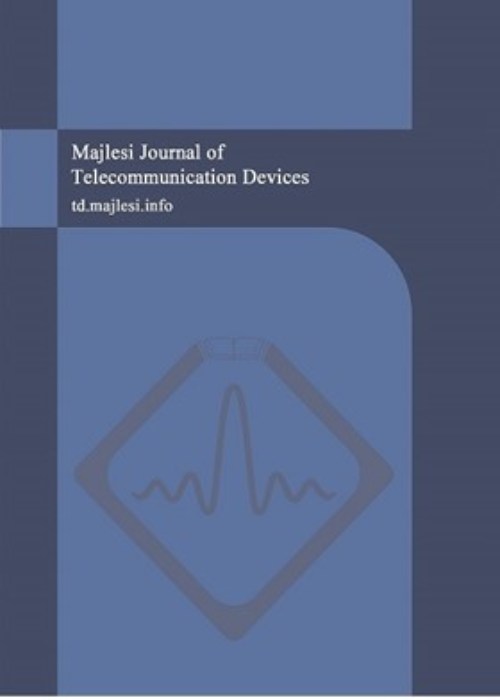فهرست مطالب
Majlesi Journal of Telecommunication Devices
Volume:4 Issue: 3, Sep 2015
- تاریخ انتشار: 1394/08/16
- تعداد عناوین: 6
-
Page 79Recently, regarding the performance of photonic crystal band-pass filters in optical networks connection, optical integrated circuits, and short wavelength with high frequency, has attracted a lot of attention. In this paper, Our goal is designing a new type of photonic crystal band-pass filters using a waveguide cavity in the form of reduction in size of the cell, that as a result we create a filter in the function of the urban wavelength with an acceptable bandwidth. Here, two types of filters have been used and optimized that the operation has been conducted by Rsoft software and FDTD two-dimensional technique. The first method is the reduction of the size of cells in waveguide and elimination of some cells in the same direction. The second method is the elimination of two cells in the vicinity of waveguide in the center of the structure. Numerical results show that the light in a band around 1.550 um passes through with maximum value. The efficiency has increased more than the previous structures, it is about 80%.Keywords: Band pass filter – resonance cavity – Band Gap – photonic crystal
-
Page 85A hybrid TDM / DWM PON network with 64 users was designed by a bidirectional optical fiber in this paper. Having analyzed the performance of the hybrid network on the basis of signal to noise ratio (SNR), the parameter was calculated for different fiber lengths. All designing procedures were performed by optisystem software and measured values were represented and evaluated. As expected, the result showed that, due to an increase in the length of the fiber, the amount of noise increased and consequently, the signal to noise ratio decreased. However, it was found that the used topology was able to receive information in both upstream and downstream for fibers with a length up to 30 km and parameters of Q factor, the bit error ratio, and the signal to noise ratio are desired and acceptable for fibers of 30 km length.Keywords: Hybrid TDM, WDM PON, SNR, OPTIWAVE
-
Page 91In this paper, using the perfect lens has created electromagnetic trap. Negative refractive index and superlenz that are two important Electromagnetic phenomenon’s are were combined to create this trap. A two-dimensional photonic crystal structure consists of a rectangular dielectric rods were used in the array. High resolution and short focal length lens makes a beam of highly concentrated and highly convergent that have the requirements for electromagnetic traps. This trap can be changed without moving the lens in the microwave frequencies.Keywords: photonic crystal, electromagnetic trap, superlens, negative refractive index
-
Page 95In this paper a new switched-line phase shifter is designed using Distributed MEMS Transmission Line (DMTL) instead of conventional transmission line. DMTL is transmission line with loaded MEMS bridges. At first using simplified model of DMTL the improved structure is analyzed. The design is explained by describing SIB frequency which minimizes return and insertion loss. The design procedure of improved structure is presented using closed-form equations. The Ansoft HFSS is used for simulation and a comparison is made between conventional and improved structures. The results show the feasibility of new design. Also it shows that the improved structure has low size and low loss compared with conventional switched-line. The simulation results show that the phase shifter creates180 degree with the average insertion loss and return loss of -1.1 dB and -38.2 dB at 2.4 GHz respectively which demonstrate an improvement in loss and isolation of the new switched-line.Keywords: Phase shifter, Switched, line, DMTL, CPW
-
Page 99Load balancing can be used to extend the lifetime of a Mesh Network and thus reducing the traffic congestion and improving the network performance. Various approaches have been proposed for load balancing in WMN. This study takes a closer look at existing solutions with the application of clustering techniques to solve routing and congestion control problems because it offers scalability and enhances the availability of network and reduced overheads. The nature of the problem of clustering is NP-hard and using meta-heuristic and evolutionary algorithms can build stable and relatively efficient clusters. This paper proposes a new clustering algorithm method in WMN networks and divide the network into k clusters to manage the load in small scale and hence to reduce the overall load of WMNs. This algorithm is a centralized method and it is designed on the basis of an imperialist competitive algorithm (ICA). A WMN is divided into multiple clusters for load control and each gateway served even number of node. A cluster head estimates traffic load in its cluster. As the estimated load gets higher, the cluster head increases the routing metrics of the routes passing through the cluster. The simulation results show that the performance of the WMNs is improved with the proposed clustering method.Keywords: Wireless Mesh Networks, Clustering, imperialist competitive algorithm, Congestion Control, Load Balancing Introduction
-
Page 107A composite artificial magnetic conductor (AMC) surface with magneto-dielectric substrate is presented for wide band radar cross section (RCS) reduction. It is shown that using of magneto-dielectric substrate can increase the in-phase reflection bandwidth of AMC structures. The composite surface consists of two kinds of AMC cells that operates at different resonance frequencies. The phase difference between these two different AMC are tuned to be close to ±π over a wide bandwidth so that the reflections from them cells cancel each other. The results show that RCS reduction more than 13 dB was achieved with a 93% bandwidth.Keywords: Radar Cross Section, Composite AMC Structure, Magneto, dielectric substrate, Broadband RCS


